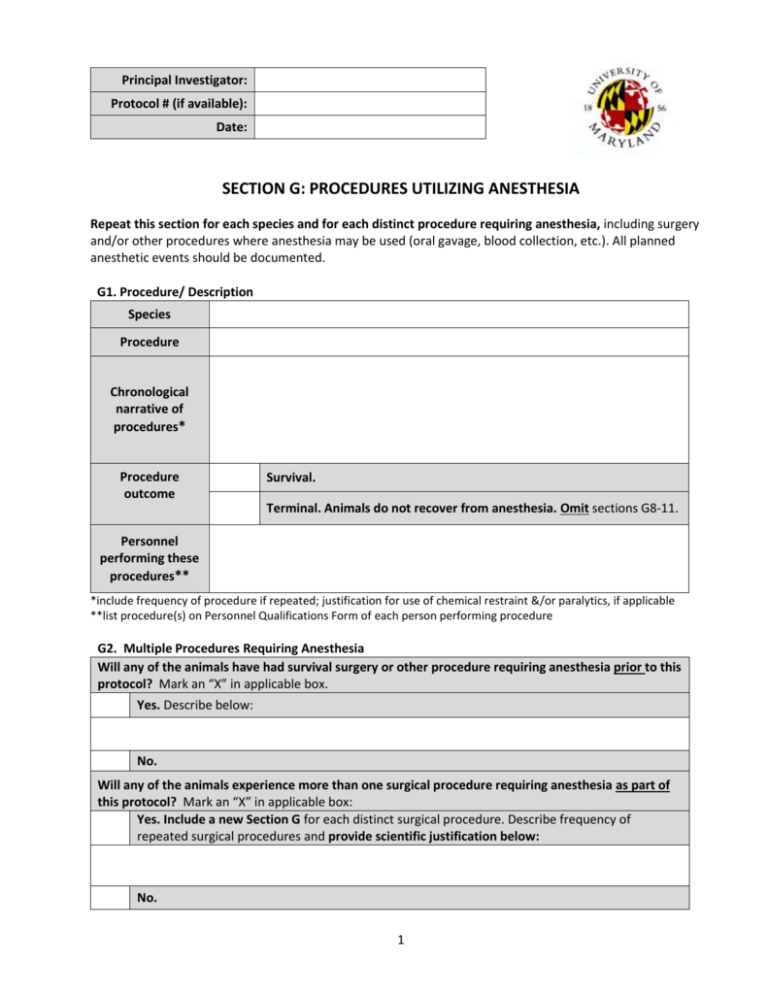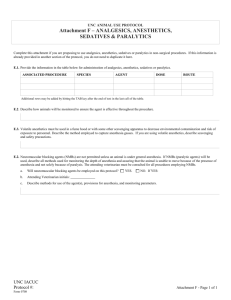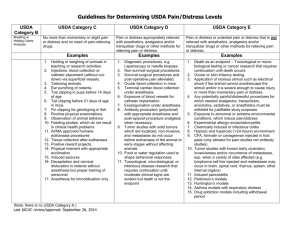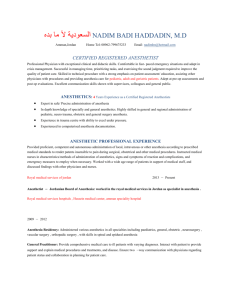DOC
advertisement

Principal Investigator: Protocol # (if available): Date: SECTION G: PROCEDURES UTILIZING ANESTHESIA Repeat this section for each species and for each distinct procedure requiring anesthesia, including surgery and/or other procedures where anesthesia may be used (oral gavage, blood collection, etc.). All planned anesthetic events should be documented. G1. Procedure/ Description Species Procedure Chronological narrative of procedures* Procedure outcome Survival. Terminal. Animals do not recover from anesthesia. Omit sections G8-11. Personnel performing these procedures** *include frequency of procedure if repeated; justification for use of chemical restraint &/or paralytics, if applicable **list procedure(s) on Personnel Qualifications Form of each person performing procedure G2. Multiple Procedures Requiring Anesthesia Will any of the animals have had survival surgery or other procedure requiring anesthesia prior to this protocol? Mark an “X” in applicable box. Yes. Describe below: No. Will any of the animals experience more than one surgical procedure requiring anesthesia as part of this protocol? Mark an “X” in applicable box: Yes. Include a new Section G for each distinct surgical procedure. Describe frequency of repeated surgical procedures and provide scientific justification below: No. 1 G3. Pre-Procedural Support Will pre-procedural support be provided? Mark an “X” in applicable box(es): No. The procedures do not require pre-procedural support. Yes. Specify pre-procedural actions and indicate method(s) below: Food withdrawal Duration of food withdrawal: Fluid withdrawal Ophthalmic ointment to eyes Clipping fur Duration of fluid withdrawal: Povidone iodine (or Chlorhexidine) + alcohol skin scrub, 3 alternating cycles Drugs or fluids (other than anesthetics) Describe below: Product Dose Route Frequency Duration of Treatment Other (describe below): G4. Intra-Procedural Support What forms of intra-procedural support will be provided? For “Method,” include type, route of administration and frequency (or continuous if applicable). Fluids Method: Supplemental Heat Method: Other Method: G5. Description of Anesthesia How will anesthetics be used? For chemical restraint (e.g., ketamine, metatomidine, isoflurane, diazepam used to immobilize/minimize stress during blood draw, injection, other procedure.) For pain relief (surgery or other potentially painful procedure) List anesthetics, sedatives: Drug Dose Route Describe how adequate anesthesia will be ensured below: 2 Frequency Duration of Treatment G6. Use of Paralytics Will paralytics be utilized? Mark an “X” in applicable box. Yes. The procedure requires paralytics. Use of paralytics must be justified in the narrative (G1). No. List anticholinergics, other paralytics: Drug Dose Route Frequency Duration of Treatment Describe how adequate depth of anesthesia and pain relief will be ensured during use of paralytics: G7 Monitoring During Anesthesia Indicate the indices that will be used for monitoring animal health while the animal is anesthetized during surgery. Mark an “X” in applicable box(es): Respiratory Rate/Effort Reflexes Mucous Membrane Heart Rate (indicate method below): Body Temperature ECG Capillary Refill Time Pulse Oxygen Oxygen Saturation Palpation Other: Auscultation G8 Monitoring During Recovery (if survival) Indicate the parameters that will be used for monitoring animal health during anesthetic recovery. Mark an “X” in applicable box(es): Respiratory Mucous membrane Capillary refill time rate/effort Activity Reflexes Body Temperature Other: G9 Monitoring for Post-Procedural Complications (e.g., monitoring for cyanosis after gavage, tissue swelling or sloughing post-injection). Will post-procedure monitoring be provided? Mark an “X” in applicable box. No. The procedures do not require post-procedural monitoring. Yes. The procedures require post-operative animal support (Describe monitoring below): 3 G10 Post-surgical care Will post-surgical care be provided? Mark an “X” in applicable box. No. The procedures do not require post-surgical support. Yes. The procedures require post-surgical animal support (Describe below): Is the procedure expected to cause pain or distress? Mark an “X” in applicable box(es). No. Pain or distress is not expected. Yes. Pain or distress during or after the procedure is possible. Will analgesics be provided? No. Analgesics will not be provided. Provide scientific justification for withholding below: Yes. List analgesics provided after recovery. Include any reversal agents used. Product Dose Route Frequency Duration of Treatment Timing of Administration Will products other than analgesics be provided (e.g., antibiotics provided at or after recovery)? Yes. No. Antibiotics are not necessary Product Dose Route Frequency 4 Duration of Treatment Timing of Administration G11 Monitoring during the study until termination (if survival) Is the procedure expected to cause chronic pain or distress? Mark an “X” in applicable box. No. Chronic pain or distress is not expected. Yes. Chronic pain or distress is possible. Identify the most likely cause of the pain or distress Mark an “X” in applicable box(es). Infectious disease Tumor burden Phenotypic side effects Antibody Post-procedure/surgical Other: production complications Identify the following: Monitoring Parameter Frequency of Obs. Action Not eating or drinking Fecal and urine output Body weight Behavioral change (guarding, hiding) Licking, biting, scratching site Hair coat (ruffled fur, lack of grooming) Posture or ambulation (tucked, stiff) Activity level (restlessness, pacing, reluctance to move) Sweating or salivation Oculonasal discharge Teeth grinding Other: Other: G12 Tissue Collection Will tissues be collected as part of this procedure? No. Tissues will not be collected. Yes. Tissues will be collected from alive, anesthetized animals (provide details below): Tissue Volume Collection Method Frequency of Collection Disposal Method AND/OR Yes. Tissues will be collected from euthanized animals. Provide details below: Tissue Collection Method Volume 5 Disposal Method




